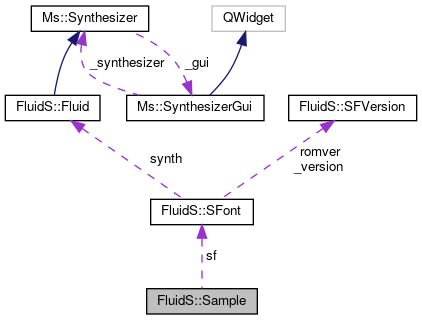#include <sfont.h>
◆ Sample()
| Sample::Sample |
( |
SFont * |
s | ) |
|
◆ ~Sample()
◆ inRom()
| bool Sample::inRom |
( |
| ) |
const |
◆ load()
◆ optimize()
| void Sample::optimize |
( |
| ) |
|
If the peak volume during the loop is known, then the voice can be released earlier during the release phase.
Otherwise, the voice will operate (inaudibly), until the envelope is at the nominal turnoff point. In many cases the loop volume is many dB below the maximum volume. For example, the loop volume for a typical acoustic piano is 20 dB below max. Taking that into account in the turn-off algorithm we can save 20 dB / 100 dB => 1/5 of the total release time. So it's a good idea to call fluid_voice_optimize_sample on each sample once.
◆ setValid()
| void FluidS::Sample::setValid |
( |
bool |
v | ) |
|
|
inline |
◆ valid()
| bool FluidS::Sample::valid |
( |
| ) |
const |
|
inline |
◆ _valid
| bool FluidS::Sample::_valid |
|
private |
◆ amplitude_that_reaches_noise_floor
| double FluidS::Sample::amplitude_that_reaches_noise_floor |
◆ amplitude_that_reaches_noise_floor_is_valid
| bool FluidS::Sample::amplitude_that_reaches_noise_floor_is_valid |
The amplitude, that will lower the level of the sample's loop to the noise floor.
Needed for note turnoff optimization, will be filled out automatically
◆ data
| short* FluidS::Sample::data |
◆ end
| unsigned int FluidS::Sample::end |
◆ loopend
| unsigned int FluidS::Sample::loopend |
◆ loopstart
| unsigned int FluidS::Sample::loopstart |
◆ origpitch
| int FluidS::Sample::origpitch |
◆ pitchadj
| int FluidS::Sample::pitchadj |
◆ samplerate
| unsigned int FluidS::Sample::samplerate |
◆ sampletype
| int FluidS::Sample::sampletype |
◆ sf
| SFont* FluidS::Sample::sf |
◆ start
| unsigned int FluidS::Sample::start |
The documentation for this class was generated from the following files:



 1.8.13
1.8.13